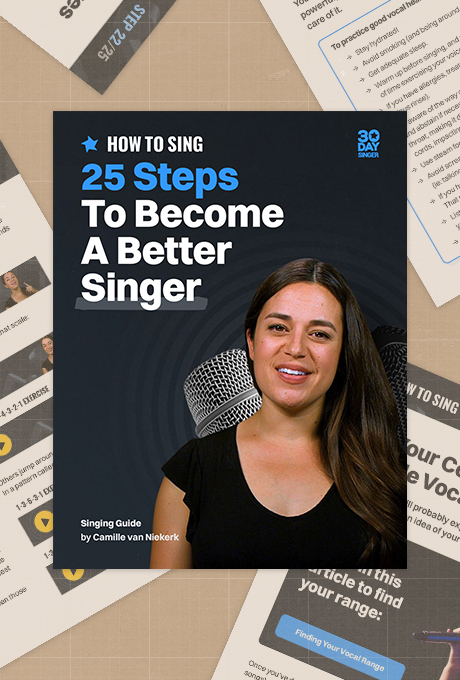5 Singing Myths DEBUNKED
January 27, 2023Camille van Niekerk
There’s no shortage of opinions and myths when it comes to singing, partly due to the fact that we all have different bodies, meaning we all have different instruments, and a singer’s experience is so subjective.
Another factor is: singing has been around forever, but vocology (the study of the voice) is relatively new, as is the ability to visualize the vocal folds in action!
1. Stop singing from your throat
This is confusing and misleading, because all sound we make happens in your throat! Your vocal folds (or vocal cords) are housed within your larynx (also called the voice box), which sits at the top of your trachea. Find your Adam’s apple, or bump in your throat, and you’ve found part of your larynx. When you’re speaking or singing, you will feel vibration in your throat, because your vocal folds are vibrating to produce sound! Telling singers to “stop singing from their throat” sometimes leads them to believe they should feel nothing in their throat, and they’re not sure where the sound is supposed to come from. A better, more accurate instruction is to let singers know that sensation is normal! What we want to notice and correct, however, are feelings of tightness or pain in the throat.
2. Sing from your diaphragm
This is well-intentioned, but again, usually confusing. Your diaphragm lowers when you inhale, and rises when you exhale. The instruction to sing from your diaphragm could be better stated as: “establish gentle engagement of your abdominal muscles when you make sound”, so that your abdominal muscles are helping to control your airflow. The easiest way to begin training that is to exhale on a strong hiss and feel the natural engagement of your abs that results; then continue that feeling of gentle engagement on a hum.
3. “Place” the sound
A popular version of this is to “place the sound in the mask”, or “use forward placement”. This language is helpful for some singers, but should always be student-led. The reality is: you cannot “place” your voice somewhere. When you make changes, like singing on a different vowel, bringing your tongue forward, or dropping your jaw, you may experience a different sensation. But because each singer has their own body and awareness of those sensations, it’s usually not helpful to “prescribe” a specific sensation based on my own body and awareness. I find it much more helpful to talk about the specific adjustment, then ask the student how it feels and sounds when we’ve achieved the desired result. If the student says something like “I feel more open in my throat”, “I feel buzzing in my cheeks”, or “I feel my air traveling through my mouth more”, then we use that!
4. You have to learn classical technique first
I don’t know how long this myth will survive, but it’s a stubborn one. Usually when people talk about classical technique, they’re referring to bel canto style and methods that have been used for hundreds of years by classical and operatic singers. They usually do a good job teaching breath management, developing a strong head voice, and nurturing vibrato usage. But if you really want to sing pop, rock, r&b, country, or contemporary musical theater, you will need training in those styles. A good contemporary teacher will also teach you breath management, strong head voice, and vibrato - but they’ll focus on the techniques and stylistic elements specific to your desired genre of singing. Classical style does not transfer to every other style of singing, and it’s not necessary to start there!
5. Singers are born, not made
This one has got to stop! It’s probably my biggest pet peeve, not only because it’s false, but because it prevents people from doing something that should bring joy to their lives. Singing is a physical and mental skill, similar to many other sports. Yes, genetics and early childhood experiences make it easier for some to learn compared to others. But, just like athletics, it’s not all or nothing! There’s a huge range of natural ability and skill level. All you can control is what you spend time learning and practicing. For me, it’s simple: if you want to sing and enjoy doing it, you should.


